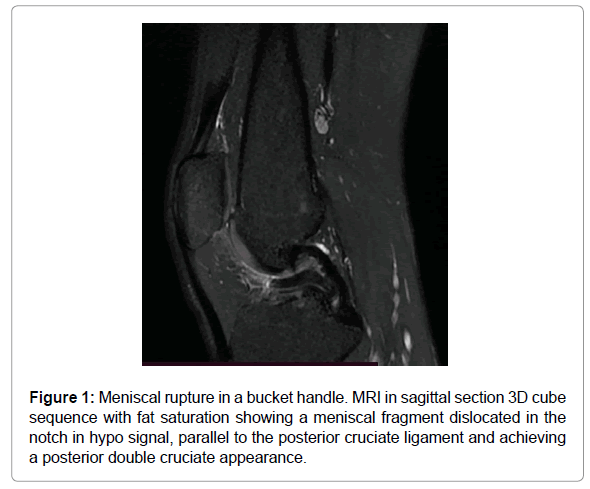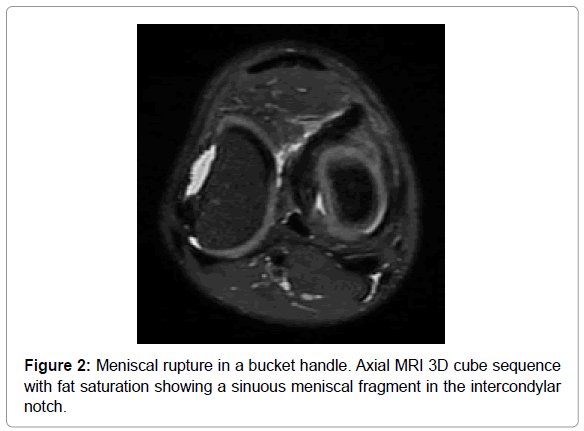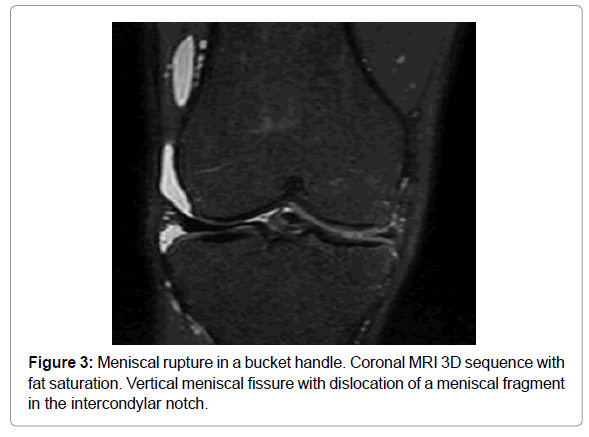The Bucket Handle
Received: 15-Apr-2021 / Accepted Date: 20-Apr-2021 / Published Date: 27-Apr-2021 DOI: 10.4172/2167-7964.1000325
Abstract
The bucket handle is a vertical longitudinal fissure in the meniscus with a mesial fragment displaced to or into the intercondylar notch. The diagnosis is made by magnetic resonance imaging, which shows a characteristic image of the posterior double cruciate ligament. We report the case of a patient with a sports accident who presents with a blocked knee.
Text
The bucket handle affects about 10% of meniscal injuries. It is predominant in young subjects and on the internal meniscus. This is an extensive longitudinal post-traumatic lesion separating the meniscus into a peripheral segment integral with the capsule and an unstable medial segment which can dislocate in the intercondylar notch [1]. Often in the course of trauma, the patient generally complains of clicking, sharp pain and especially blockage in the extension of the knee, which is the main symptom. The diagnosis is mainly based on MRI.
On MRI in sagittal slices, we can find the sign of the posterior double cruciate ligament (PCL) which corresponds to a meniscal fragment displaced in the intercondylar notch generally parallel to the posterior cruciate ligament (Figure 1). The meniscal fragment is displaced anteriorly and inferior to the LCP. This is a not very sensitive but very specific sign of a meniscal rupture in a bucket handle [2]. Another possible aspect is that of the anterior double horn showing a posterior fissure with residual central attachment and a meniscal fragment dislocated anteriorly. The fragment can also dislocate laterally from the anterior horn and create an anterior megacorn [3]. In axial sections, the meniscal fragment appears sinuous in the notch and folded back on itself (Figure 2) [4]. In coronal slices, the body of the meniscus is truncated, small in size with individualization of a meniscal fragment in the mesial compartment or displaced in the intercondylar notch (Figure 3) [2]. Currently, the treatment of a meniscal rupture in a bucket handle is mainly arthroscopic surgery.
References
- Ravey JN DC (2013) Imagerie par résonance magnétique des lésions méniscoligamentaires du genou. EMC - Radiologie et imagerie médicale - musculosquelettique - neurologique - maxillofaciale 8:1-26.
- Blankenbaker DG (2020) Imagerie musculosquelettique traumatique. Elsevier Masson SAS474-7.
- Aydingöz U, Firat AK, Atay OA, Doral MN (2003) MR imaging of meniscal bucket-handle tears: a review of signs and their relation to arthroscopic classification. European Radiology 13:618-625.
- Dorsay TA, Helms CA (2003) Bucket-handle meniscal tears of the knee: sensitivity and specificity of MRI signs. Skeletal Radiology 32:266-272.
Citation: Behyamet O, Mohamed TWY, Thierry YTR, Nassar I, Billah NM (2021) The Bucket Handle. OMICS J Radiol 10: 325. DOI: 10.4172/2167-7964.1000325
Copyright: © 2021 Behyamet O, et al. This is an open-access article distributed under the terms of the Creative Commons Attribution License, which permits unrestricted use, distribution, and reproduction in any medium, provided the original author and source are credited.
Share This Article
Open Access Journals
Article Tools
Article Usage
- Total views: 2214
- [From(publication date): 0-2021 - Mar 29, 2025]
- Breakdown by view type
- HTML page views: 1501
- PDF downloads: 713



